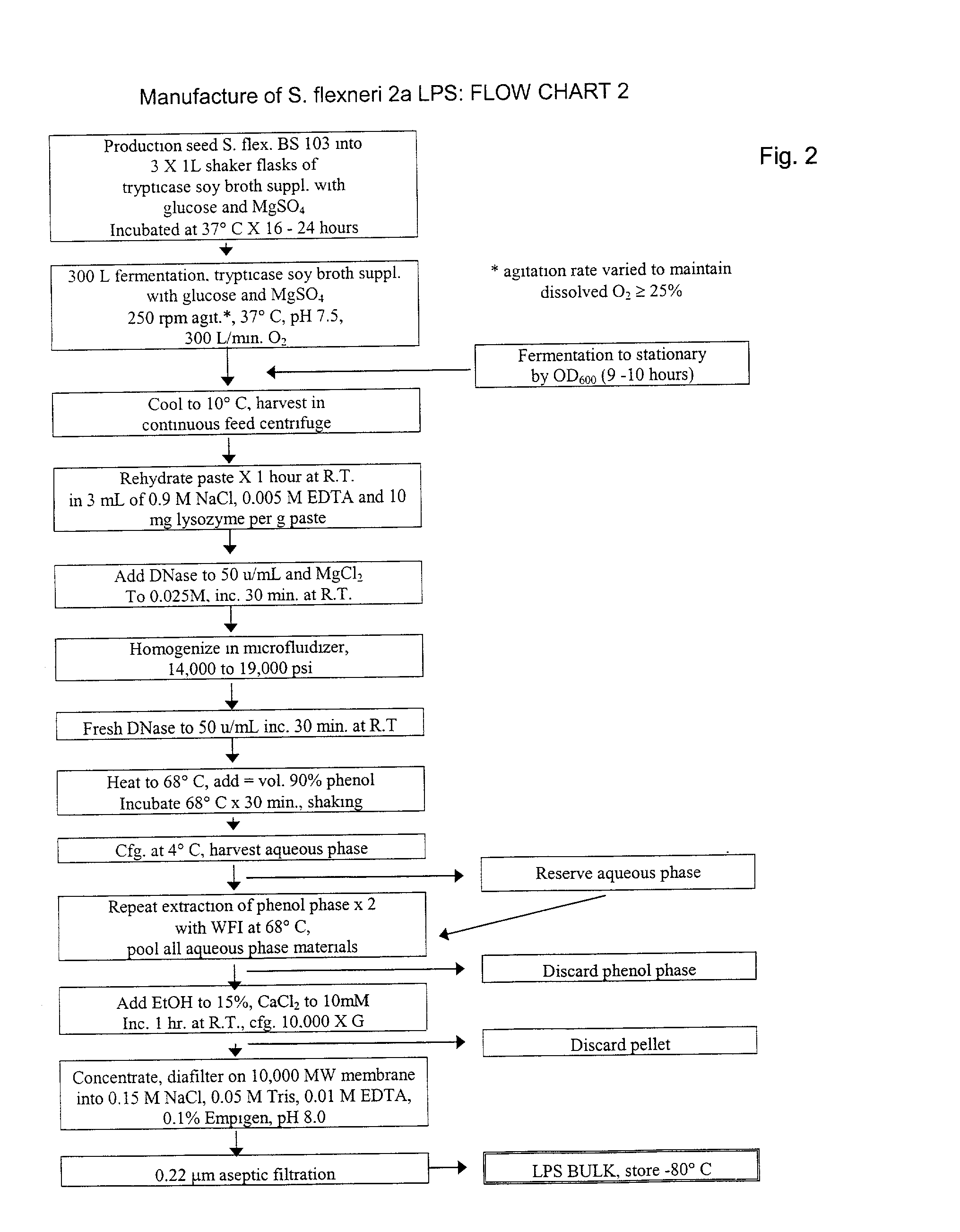Proteosome-liposaccharide vaccine adjuvant
a technology of liposomes and vaccines, applied in the field of adjuvants, can solve the problem of up to three years of repeated immunizations
- Summary
- Abstract
- Description
- Claims
- Application Information
AI Technical Summary
Benefits of technology
Problems solved by technology
Method used
Image
Examples
example 1
Production of Proteosomes
[0047]Two examples of outer membrane protein proteosome preparations are shown. These preparations were purified from type 2 Neisseria meningitidis by extraction of phenol-killed bacterial paste with a solution of 6% Empigen BB (EBB) (Albright and Wilson, Whithaven, UK) in 1 M calcium chloride followed by precipitation with ethanol, solubilization in 1% EBB-Tris / EDTA-saline and then precipitation with ammonium sulphate. The precipitates were re-solubilized in the 1% EBB buffer, diafiltered and stored in an EBB buffer at −70° C. A flow chart of this process, which resulted in proteosomes having a liposaccharide content of between 0.5% and 5%, is shown in Flowchart 1A (FIG. 1A) on the following pages. Proteosomes may also be prepared by omitting the ammonium sulphate precipitation step to shorten the process as desired with resultant proteosomes having a liposaccharide content of between 12% and 25%, and may, depending upon the materials, be between 15% and 20...
example 2
Production of Liposaccharides
[0048]The example in Flowchart 2 (FIG. 2) shows the process for the isolation and purification of LPS from S. flexneri or P. shigelloides bacteria. This process can similarly be used for preparing LPS from other gram-negative bacteria including, but not restricted to Shigella, Plesiomonas, Escherichia and Salmonella species. Following growth of the bacteria by fermentation, the cell paste was re-hydrated with 3 mL 0.9M NaCl, 0.005 M EDTA / g paste. Ten mg lysozyme / g paste was also added. Lysozyme digestion was allowed to proceed for 1 hour at room temperature. Fifty U / mL Benzonase (DNase) was then added with 0.025M MgCl2. DNase digestion was allowed for 30 minutes to proceed at room temperature. The suspension was then cracked by passage through a microfluidizer at 14,000 to 19,000 psi. Fresh DNase (50 U / mL) was added and the suspension was digested for a further 30 min at room temperature. The digested cell suspension was heated to 68° C. in a water bath....
example 3
Preparation and Characterisation of a Proteosome-Liposaccharide Adjuvant Complex
[0050]The adjuvant is manufactured by non-covalently complexing Proteosomes to LPS. The LPS can be derived from any of a number of gram negative bacteria including, but not limited to Shigella or Plesiomonas or Escherichia or Salmonella species as described in Flowchart 3. Briefly, proteosomes and LPS were thawed overnight at 4° C. and adjusted to 1% Empigen BB in TEEN buffer. Proteosomes were thawed overnight and adjusted to 1% Empigen BB in TEEN buffer. The two components were mixed at quantities resulting in a final Proteosome:LPS wt / wt ratio of between 10:1 and 1:3 and stirred for 15 minutes at room temperature. The LPS-Proteosome mixture was diafiltered on an appropriately sized (e.g. Size 9) 10,000 MWCO hollow fiber cartridge into TNS buffer (0.05 M Tris, 150 mM NaCl pH 8.0). The diafiltration was stopped when Empigen content in the permeate was <50 ppm (by Empigen Turbidity Assay or by a Bradford ...
PUM
| Property | Measurement | Unit |
|---|---|---|
| temperature | aaaaa | aaaaa |
| temperature | aaaaa | aaaaa |
| pH | aaaaa | aaaaa |
Abstract
Description
Claims
Application Information
 Login to View More
Login to View More - R&D
- Intellectual Property
- Life Sciences
- Materials
- Tech Scout
- Unparalleled Data Quality
- Higher Quality Content
- 60% Fewer Hallucinations
Browse by: Latest US Patents, China's latest patents, Technical Efficacy Thesaurus, Application Domain, Technology Topic, Popular Technical Reports.
© 2025 PatSnap. All rights reserved.Legal|Privacy policy|Modern Slavery Act Transparency Statement|Sitemap|About US| Contact US: help@patsnap.com



